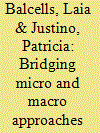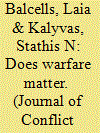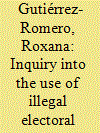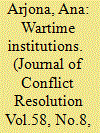|
|
|
Sort Order |
|
|
|
Items / Page
|
|
|
|
|
|
|
| Srl | Item |
| 1 |
ID:
134940


|
|
|
|
|
| Summary/Abstract |
This article reflects on the importance of linking micro and macro levels of analysis in order to advance our current understanding of civil wars and political violence processes and discusses the contributions of the articles in this special issue. We first identify the main problems in research on political violence that is focused on a single level of analysis and describe the challenges faced by research that attempts to establish connections between different levels. We then introduce the different articles in the special issue, with an emphasis on the micro–macro-level linkages they develop and highlighting their commonalities. We conclude by emphasizing the importance of a new research agenda for the study of civil wars and political violence that bridges social, economic, and political dynamics occurring at the local level and conflict processes taking place in the macro arena.
|
|
|
|
|
|
|
|
|
|
|
|
|
|
|
|
| 2 |
ID:
134943


|
|
|
|
|
| Summary/Abstract |
This article examines desertion in civil wars, focusing on the role of combatants’ hometowns in facilitating desertion. Analyzing data from the Spanish Civil War, the article demonstrates that combatants who come from hill country are considerably more likely to desert than combatants whose hometowns are on flat ground. This is because evasion is easier in rough terrain. The finding implies that the cohesion of armed groups depends on control, not just positive incentives, and that control of territory in civil wars goes beyond rebel–government contestation, and consists also of control behind the lines. The article bridges micro and macro approaches to civil wars by indicating the multiple uses to which individuals can put structural conditions like rough terrain. This helps to clarify the macro-level link between rough terrain and civil war. It also shows that micro-level research can profitably examine structural variables alongside individual characteristics and endogenous conflict dynamics.
|
|
|
|
|
|
|
|
|
|
|
|
|
|
|
|
| 3 |
ID:
134942


|
|
|
|
|
| Summary/Abstract |
Does it matter whether a civil war is fought as a conventional, irregular, or symmetric nonconventional conflict? Put differently, do “technologies of rebellion” impact a war’s severity, duration, or outcome? Our answer is positive. We find that irregular conflicts last significantly longer than all other types of conflict, while conventional ones tend to be more severe in terms of battlefield lethality. Irregular conflicts generate greater civilian victimization and tend to be won by incumbents, while conventional ones are more likely to end in rebel victories. Substantively, these findings help us make sense of how civil wars are changing: they are becoming shorter, deadlier on the battlefield, and more challenging for existing governments—but also more likely to end with some kind of settlement between governments and armed opposition. Theoretically, our findings support the idea of taking into account technologies of rebellion (capturing characteristics of conflicts that tend to be visible mostly at the micro level) when studying macro-level patterns of conflicts such as the severity, duration, and outcomes of civil wars; they also point to the specific contribution of irregular war to both state building and social change.
|
|
|
|
|
|
|
|
|
|
|
|
|
|
|
|
| 4 |
ID:
134945


|
|
|
|
|
| Summary/Abstract |
Using a panel data set from Burundi where information on protection payments during the twelve-year civil war was collected, we test the relationship between payments, the nature of extraction by the rebels, and the welfare outcomes. We ask, “Does payment to rebels insure against future welfare loss and does the nature of payment matter? Specifically, does the level of institutionalization of extraction within the rebel governance structure provide a form of insurance for future welfare?” No less than 30 percent of the interviewees made at least one payment. Rebels extract these taxes through one of the following two routes: an “institutionalized” and regular cash-with-receipt method or an ad hoc and unpredictable labor extraction. Using matching methods, we find that payment through the institutionalized route increases household welfare between 16 and 25 percent. Ad hoc extraction has no effect. We situate our findings in the empirical literatures on contributions to mafia-type organizations and rebel governance.
|
|
|
|
|
|
|
|
|
|
|
|
|
|
|
|
| 5 |
ID:
134944


|
|
|
|
|
| Summary/Abstract |
This article analyzes the determinants of household riot victimization, based on a unique survey collected in Maharashtra, India. We adopt a multilevel framework that allows neighborhood and district effects to randomly influence household victimization. We find that economically vulnerable households, households living close to unsafe areas, and shop owners are more prone to suffer from riots. Households report lower levels of victimization if they live further from police stations, exhibit higher levels of trust, are able to rely on outside help in times of need and accumulate savings. The results show, however, a double-edge effect of income: wealthier households are better able to cope with the adverse effects of riots, but also have more to lose from riots and are more exposed to opportunistic violence and looting. We find further that affluent neighborhoods and neighborhoods where caste fragmentation is high report higher levels of victimization. Neighborhoods with stronger social interactions experience lower levels of victimization.
|
|
|
|
|
|
|
|
|
|
|
|
|
|
|
|
| 6 |
ID:
134946


|
|
|
|
|
| Summary/Abstract |
This article investigates whether vote-buying and the instigation of violence in the disputed 2007 Kenyan elections were strategically motivated and whether those affected by vote-buying or post-electoral violence changed their views toward ethnopolitics and the use of violence. To answer these questions, a panel survey conducted before and after the elections is combined with external indicators of electoral violence. We find that vote-buying was used to mobilize parties’ own strongholds. Political parties also targeted vote-buying and threats toward specific ethnic groups and areas, potentially to weaken the support of their political rivals. In addition, we find that the victims of post-electoral violence are more likely to identify in ethnic terms and support the use of violence. The non-victims of post-electoral violence, but who experienced vote-buying after our first survey are also more likely to support the use of violence.
|
|
|
|
|
|
|
|
|
|
|
|
|
|
|
|
| 7 |
ID:
134941


|
|
|
|
|
| Summary/Abstract |
Theories of civil war usually theorize the choices of civilians and combatants without considering the institutional context in which they interact. Despite common depictions of war as chaotic and anarchic, order often emerges locally. Institutions vary greatly over time and space and, as in peacetime, shape behavior. In this article, I propose a research agenda on local wartime institutions. To this end, I present original evidence on conflict areas in Colombia to illustrate the scope of variation, propose the concept of wartime social order and a typology, and discuss several ways in which research on wartime institutions can contribute to our study of civil war both at the micro and macro levels.
|
|
|
|
|
|
|
|
|
|
|
|
|
|
|
|
|
|
|
|
|